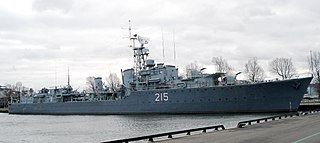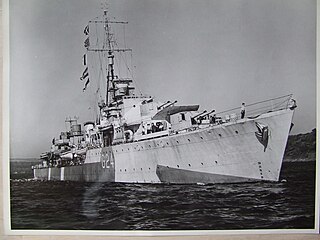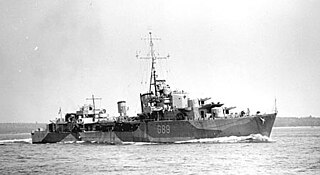Related Research Articles

HMCS Haida is a Tribal-class destroyer that served in the Royal Canadian Navy (RCN) from 1943 to 1963, participating in World War II and the Korean War. She was named for the Haida people.

HMCS Athabaskan was the first of three destroyers of the Royal Canadian Navy to bear this name. It was a destroyer of the Tribal class, that served in the Second World War. She was named for the First Nations peoples who make up the Athabaskan language group. She was torpedoed in the English Channel and sunk in 1944.

HMCS Athabaskan was a Tribal-class destroyer that served with the Royal Canadian Navy in the immediate post-Second World War era. She was the second destroyer to bear the name "Athabaskan", after the many tribes throughout western Canada that speak Athabaskan family languages. Both this ship and the original HMCS Athabaskan were destroyers and thus this one became known as Athabaskan II.

HMCS Nootka was a Tribal-class destroyer that served in the Royal Canadian Navy (RCN) from 1946 to 1964. Constructed too late to take part in the Second World War, the ship saw service in the Korean War. She received the unit name Nootka while still under construction in Halifax, Nova Scotia after the RCN renamed the Fundy-class minesweeper Nootka (J35) to Nanoose (J35) in 1943. Nootka was the second Canadian Tribal to be constructed in Canada and the second Canadian warship to circumnavigate the world. The ship was sold for scrap and broken up at Faslane, Scotland in 1965.

The Tribal class, or Afridi class, were a class of destroyers built for the Royal Navy, Royal Canadian Navy and Royal Australian Navy that saw service in World War II. Originally conceived during design studies for a light fleet cruiser, the Tribals evolved into fast, powerful destroyers, with greater emphasis on guns over torpedoes than previous destroyers, in response to new designs by Japan, Italy, and Germany. The Tribals were well admired by their crews and the public when they were in service due to their power, often becoming symbols of prestige while in service.
Several Canadian naval units have been named HMCS Huron.
Several Canadian naval units have been named HMCS Iroquois.

HMCS Cayuga was a Tribal-class destroyer that served in the Royal Canadian Navy from 1946 until 1964. She saw action in the Korean War. She was named for the Cayuga nation, a First Nations people of Canada.

HMCS Huron was a Tribal-class destroyer that served in the Royal Canadian Navy in the Second World War and the Korean War. She was the first ship to bear this name, entering service in 1943. She was named for the Huron people. During the Second World War the vessel saw service in Operation Neptune in the Bay of Biscay and along the French coast in support of the invasion of Normandy and escorted convoys to the Soviet Union. Following the war, the ship was placed in reserve. The destroyer was activated in 1950 as a training ship, but with the onset of the Korean War, was modernized and deployed twice to Korea. Following the war, Huron reverted to a training ship and took part in Cold War-era North Atlantic Treaty Organization (NATO) naval exercises until being paid off for the final time in 1963 and broken up for scrap in 1965.

HMCS Micmac was a Tribal-class destroyer which served the Royal Canadian Navy from 1945 to 1964. Micmac was the first modern, high-performance warship built in Canada. She was the first of four Tribal destroyers built at the Halifax Shipyard and one of eight Tribal-class destroyers to serve in the Royal Canadian Navy.

HMCS Iroquois was a Tribal-class destroyer that served in the Royal Canadian Navy during the Second World War and Korean War. She was named for the Iroquois First Nations. Iroquois was the first ship to bear this name and the first ship of the class to serve with the Royal Canadian Navy.

HMCS Sioux was a V-class destroyer of the Royal Canadian Navy which fought in the Second World War and the Korean War. She was launched as HMS Vixen for the British Royal Navy before being transferred to the Royal Canadian Navy. She was then named for the Sioux people of Canada's western provinces.
Several Canadian naval units have been named HMCS Chaudiere.

HMCS Crescent was a C-class destroyer that was built for the Royal Navy but was transferred before completion and saw active service with the Royal Canadian Navy. She was one of 32 destroyers of that class built between 1943 and 1945 as part of the War Emergency Programme.

Vice Admiral Henry George DeWolf was a Canadian naval officer who was famous as the first commander of HMCS Haida during the Second World War.
Several Canadian naval units have been named HMCS Kootenay.
Several Canadian naval units have been named HMCS Restigouche.
Several Canadian naval units have been named HMCS Gatineau.
Several Canadian naval units have been named HMCS Saskatchewan.